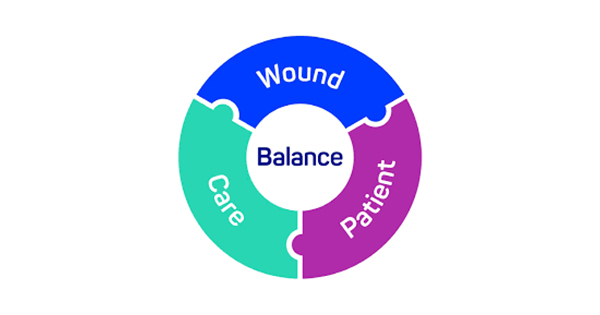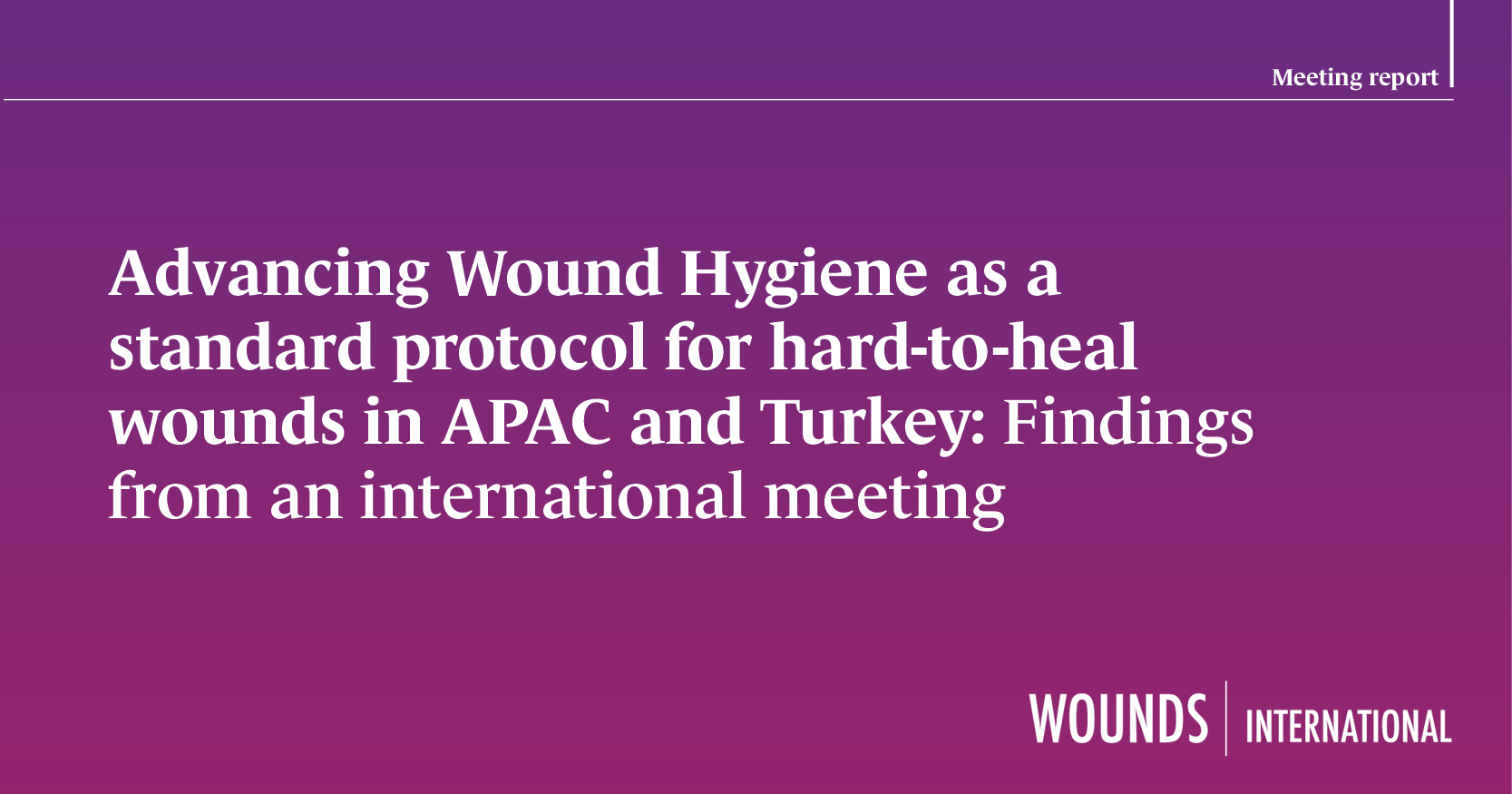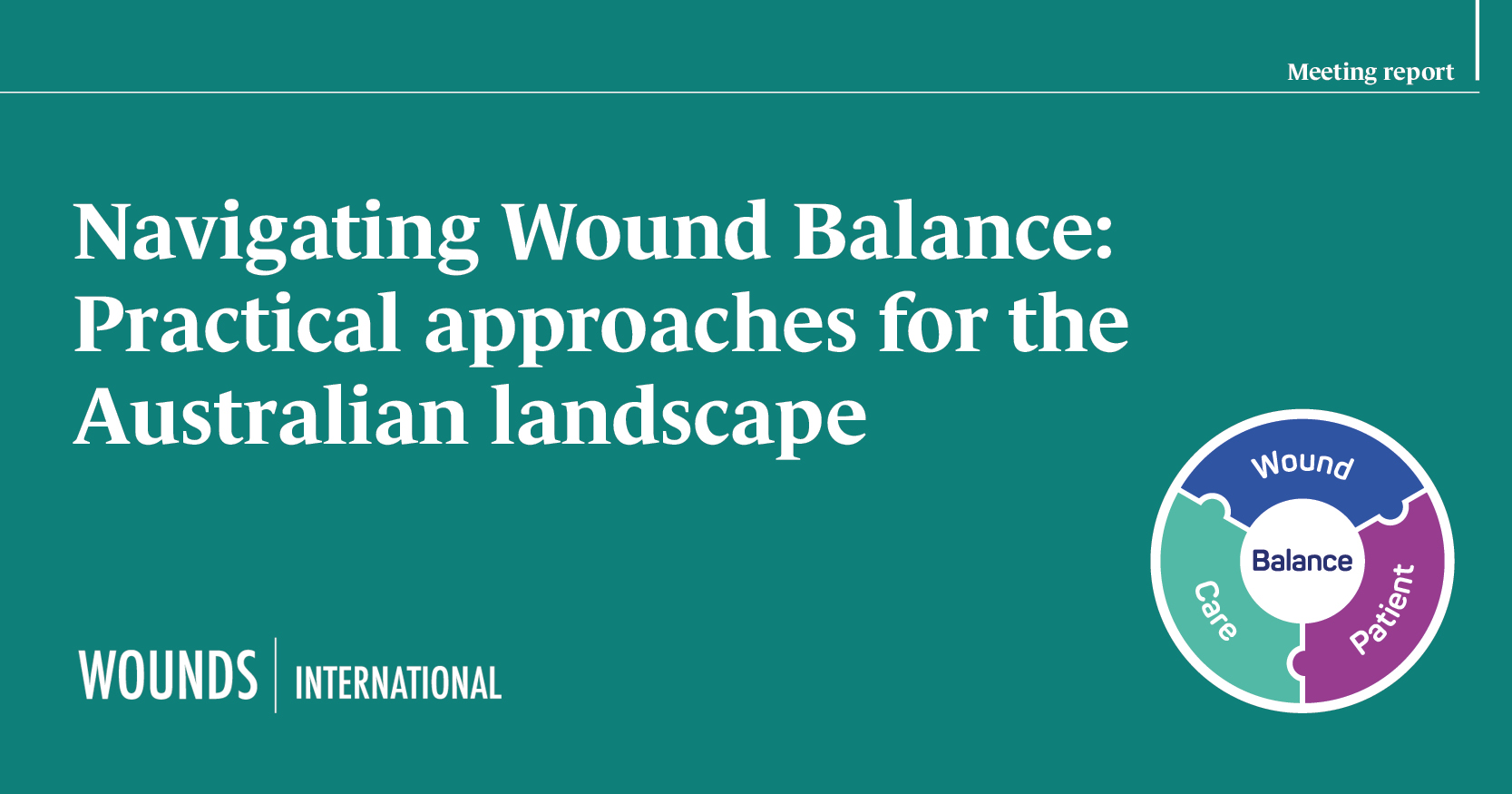This publication represents the outcome of a meeting of international wound care experts held in Barcelona, Spain, in October 2023. In 2022, a document was published introducing the concept of Wound Balance: a multifactorial approach to achieving wound healing, encompassing scientific understanding, patient-centred care and clinical decision-making (Wounds International, 2023; figure 1). This current document represents a further step in the development and implementation of this concept, specifically with the aim of providing a summary of the expert group’s recommendations regarding:
- Providing wound care in the most appropriate setting for each individual patient
- Assessing quality of life (QoL) in people with chronic wounds, both in clinical research and in everyday practice
- Educational needs of non-specialist healthcare professionals regarding wound care
- Strategies for disseminating education on wound balance to a wider population of healthcare professionals, patients and carers.
The expert group comprised wound care professionals and educators from seven different countries, and so this document represents the experiences of clinicians and researchers working within a multitude of different healthcare and academic settings.
Providing wound care in the most appropriate setting
The setting in which people receive care can make a difference to their experience of that care. With healthcare systems across the world under pressure due to limited time and increasing workloads, ensuring that people receive the level of care that is appropriate for them is also important to protect limited specialist resources. Most people with chronic wounds are able to receive care from their primary care and community care teams, while specialist clinics and staff are preserved for cases where they are most needed.
However in practice, many patients who would benefit from expert referral experience long delays in accessing that care. The expert group perceived that this may in part be due to a knowledge gap regarding wound care for non-specialist healthcare professionals. Medical and nursing qualifications in many countries devote very little time to providing education on wounds and wound care. Although leg ulcer care in developed countries is primarily provided in the community (Barrett et al, 2009), basic wound care principles are not always covered in primary care education systems, even for qualified healthcare professionals. National and international guidelines exist; however, these are often long and detailed, making them more suited to specialists and less accessible or user-friendly for primary care.
Clinicians may therefore feel that they lack the specialised knowledge or the confidence to implement Wound Balance strategies themselves. They may also be deterred by the perceived time burden of applying or reapplying dressings during consultations. This results in patients being referred to wound clinics for care of wounds that could potentially have been managed in a setting closer to their home.
Additionally, clinicians who lack specific knowledge about wound care may not know how to recognise, diagnose or treat a wound – leading to delays in patients receiving appropriate care – or to identify red flags indicating an immediate need for attention.
To address these concerns, the expert group felt a simple guide was needed on providing care to patients with a newly identified wound. This guide would serve three purposes:
- Reduce waiting times for patients to receive appropriate wound care, by raising awareness of the importance of early intervention, supporting earlier referrals to specialist care and assisting primary care providers to make treatment decisions in the interim
- Reassure and empower clinicians to provide care before specialist input is available
- Offer a simple therapeutic protocol that could standardise first-line treatment measures and reduce unwanted variations in care.
Figure 2 shows a suggested early treatment algorithm for non-specialist wound care clinicians.
For many areas of wound care, no single gold standard of care currently exists. The Cochrane systematic review on dressings and topical treatment for venous leg ulcers in 2018 included 59 separate studies, covering 40 different comparisons between treatments (Norman et al, 2018); given this broad range of research, it is difficult to draw conclusions about the single most effective treatment option from the current evidence. This treatment algorithm attempts to provide some top-level guidance on best practice care that should be applicable to the majority of patients with wounds encountered in primary care.
Red flags
The first box on the algorithm recommends clinicians check for the presence of red flags – critical risk factors requiring emergent treatment to prevent permanent harm to life or limb.
If none of these factors are present, it is reasonable for the wound to be initially managed within primary or community care with involvement from specialist clinicians to assist in obtaining a diagnosis, if required. These specialist clinicians do not need to be based in a wound care clinic; a specialist GP or community nurse may be able to provide support to other primary care colleagues without the need to refer patients outside of the practice.
First-line care
The focus of the initial care is assessing and managing the wound bed. The expert group agreed that assessment should be performed according to the TIMERS principle: tissue, infection, moisture balance, edges, regeneration and social components (Atkin et al, 2019).
The wound should then be cleaned and a suitable dressing applied. This basic level of wound care can be provided even before a definitive diagnosis is made. Exact protocols for which substance to cleanse the wound with are likely to vary between local areas.
Likewise, the wide range of dressings available on the market may appear confusing or complex for non-specialist clinicians. Different dressings may also be available depending on the country’s healthcare system or the job role of the healthcare professional – in some systems, some forms of dressing are not available to be prescribed by community nurses.
The aim of the Wound Balance-based algorithm was then to provide as universal a recommendation as possible. Specific brands may vary between clinics, but the expert group agreed that selecting a silicone superabsorbent dressing would be an appropriate first dressing choice, regardless of the wound type, because of its atraumatic removal, ability to deal with exudate, and suitability for wounds with both high and low protease levels. If necessary, the dressing type can be changed when the patient is assessed by a wound care professional.
Compression
The expert group were in unanimous agreement that compression therapy was part of best-practice care for leg ulcers; however, they recognised that there were significant barriers to its implementation by non-specialists:
- Waiting for investigations – in some settings (e.g., the UK), first-line compression therapy may be applied in the absence of red flags; however, a full assessment including ankle brachial pressure index measurement must be performed by an appropriately trained and competent practitioner before full compression therapy (>20mmHg of pressure) is possible (NICE, 2023)
- Fear of causing harm – incorrectly applied compression may be ineffective, can cause pain, and risks creating a new iatrogenic wound. Although a systematic review found that severe adverse effects were very rare and most adverse effects were non-severe effects such as skin irritation (Rabe et al, 2020), for some primary care professionals the risks are unacceptable; this may also be due to fear of liability
- Lack of education – many primary care doctors have not received specific training or education on prescribing compression therapy, and therefore lack the confidence or knowledge to do so. If compression is applied, this may be ineffective or harmful if the provider was not sufficiently competent to apply the compression correctly
- Lack of time – compression therapy must be reapplied each time a dressing is changed; this places a workload burden on the healthcare professionals, predominantly nurses, providing this care
- Lack of reimbursement – in some healthcare systems (such as France), applying compression hosiery is not recognised for financial reimbursement.
Given the strength of evidence supporting compression therapy in venous leg ulcers, the expert group felt it was appropriate to include this in the algorithm, but recognised that many primary care clinicians will not be able to apply this. Hosiery or wraps were suggested as these are often easier for non-specialists to apply compared to bandage systems.
First-line compression should be applied only by practitioners who are competent and able to do so. Full compression, in the form of hosiery, wraps or bandages, should be applied only following comprehensive assessment (including ABPI measurement) to rule out any underlying peripheral arterial disease.
Slow wound healing and referral
The second set of factors to be considered are those that are not clinical emergencies but may interfere with wound healing; must be considered in the context of the patient’s overall medical history, psychological status and social factors, such as their living situation.
The expert group felt it was not possible to set an exact timeframe for when a wound should be considered non-healing and the patient referred to specialist care; 2–6 weeks was suggested, but this may not be viable in every country’s healthcare system. The crucial goal of this step of the algorithm was to ensure that patients are followed up in a timely manner, and any who do need specialist intervention can access this as early as possible in their healing journey.
Wound-QoL tool: assessing a patient’s need for holistic care
Chronic wounds are associated with a negative impact on QoL. Approximately 30% of patients with chronic wounds have concomitant anxiety and/or depression – three times higher than the rate of depression in people without chronic wounds (Renner and Erfurt-Berge, 2017). For people living with chronic wounds, it is important that care is not focused solely on healing but also incorporates an understanding of their experience living with a chronic condition, symptom management, and measures designed to improve their overall wellbeing (Fearns et al, 2017).
The Wound-QoL tool is a questionnaire designed to assess QoL in patients living with chronic wounds, across three scales: everyday life, body, and psyche (Blome et al, 2014). The questionnaire comes in two forms, the original 17-item questionnaire and a shortened 14-item version (von Stülpnagel et al, 2021); the 14-item version is recommended for research due to its improved psychometric performance over the original, but both forms are equally recommended for clinical practice, depending on whether brevity or depth of information is preferred. Both forms assess patients’ impairments over the past 7 days, and specifically address wound-related factors.
Use of the Wound-QoL tool provides an additional dimension for quantifying wound healing and quality of care provided, by allowing not only changes in wound size to be tracked over time, but also changes in patient wellbeing; recording a patient’s Wound-QoL scores at repeated clinic visits provides longitudinal data on their level of impairment. The questionnaire, originally developed in German, has been translated into a further 36 languages. It should be noted that there are some limitations to using the Wound-QoL tool; for example, it may not be suitable in patients with severe cognitive impairment.
Relationship between treatment and Wound-QoL scores
Some treatments may cause a temporary increase in pain for the patient: for example, surgical treatments such as sharp debridement are associated with increased pain; compression therapy also commonly causes discomfort, and is particularly unpopular in hot or humid climates (Mani et al, 2019). Therefore, there is a possibility that the treatment itself may lower a patient’s QoL.
No studies have yet been done to assess whether Wound-QoL tool measurements performed after aggressive treatments provide different results to those performed after gentler treatment. The Wound-QoL asks the patient to rate their level of impairment over the previous 7 days and therefore, a short-term intervention such as debridement should have a limited effect on the overall scores from the past week; however, the current level of pain may impact a patient’s perception of their impairment retrospectively.
Although debridement is associated with increased pain and increased wound size, it also results in a “better-looking” wound – one with less viable necrotic tissue and debris. This can be a motivational factor for patients, which may in turn positively impact their perception of their wound. Collecting Wound-QoL tool data periodically at clinic visits also allows a patient to see changes in their score over time, which again, may provide motivation, particularly for patients with slow-healing wounds where visible progress may be difficult to see.
The Wound-QoL tool could have potential value when evaluating new treatment options where short-term discomfort is expected. Poor tolerability and comfort are among the factors that contribute to non-adherence to wound care (Moffat et al, 2017); hence even a highly effective treatment may not be considered acceptable to patients if it negatively affects their QoL.
Using the Wound-QoL tool to navigate healthcare systems
Treatment approval or reimbursement decisions are increasingly based not only on clinical efficacy, but also on “secondary criteria” such as improvements in pain or other QoL indicators (Téot et al, 2006), so measurements such as the Wound-QoL tool offer an additional way to demonstrate potential benefits and cost-effectiveness of a treatment.
For patients already receiving treatment, ongoing treatment provision may be dependent on the ability to show benefit; for slow-healing wounds, that may not have much physical improvement after treatment; measuring QoL is one way to demonstrate treatment efficacy. This may also be the case for older patients or those approaching the end of life – where complete wound healing is no longer an appropriate goal, but QoL improvements are still possible through palliative care approaches to wound care.
Case example: In the US, the Patient-Reported Outcomes Measurement Information System (PROMIS) is frequently used to assess physician performance. Improvement in patient-reported outcomes, as measured by the Wound-QoL tool, may be helpful to clinicians in demonstrating positive outcomes from their clinic – particularly as the slow-healing nature of some chronic wounds means patients may not see any clinical improvements for several months.
Benefits of using the Wound-QoL tool in practice
As well as measuring the benefit from treatment interventions, assessing QoL could potentially be considered an intervention in itself. Anxiety and depression are associated with slower wound healing (Gouin and Kiecolt-Glaser, 2011), which in turn, leads to increased healthcare costs and resource use – early detection and management of psychosocial problems could reduce overall costs of care.
Consideration of QoL by a healthcare professional is considered important to patients, and is linked to greater satisfaction with care (Squitieri et al, 2020). Healthcare professionals’ empathy has a positive effect on therapeutic alliance between patient and physician, and may even affect clinical outcomes. Studies in patients with chronic pain have shown that a perception of clinician empathy is associated with reduced pain and improved health-related QoL (Canovas et al, 2018). A person-centered approach, taking into consideration QoL, also empowers patients to take responsibility for their care and improves concordance with agreed treatment plans (Gethin et al, 2020).
Case example: A wound care clinic in Germany moved patients’ appointments for aggressive debridement treatment to the specialist hospital setting, rather than the community, and increased the length of each appointment to 1 hour. Despite the increased time spent in appointments, and the longer travel times to reach the specialist setting, patients reported higher levels of satisfaction with their care. The longer appointment time improved the patient’s experience of care by ensuring they did not feel rushed, and patients reported that they were able to build a good therapeutic relationship with the clinicians providing their care. Although providing longer appointment times is difficult in many healthcare systems, it offers the potential for substantial benefits in improving not only wound healing but also QoL.
Challenges of implementing the Wound-QoL tool
The greatest barrier seen with using the Wound-QoL tool in real practice was time. Although measuring and reviewing a patient’s Wound-QoL scores at every visit would provide a great opportunity for individualising care, it is not practical in many clinics. Instead, the Wound-QoL score can be determined periodically and then reviewed if wound healing plateaus or patient satisfaction decreases. Improved QoL – including increased activities of daily living or reduced pain over time – can provide tangible indicators of progress.
A further challenge identified by the expert group was the ability to act on the results of the Wound-QoL tool. Due to time pressures, there is a risk that patients complete the questionnaire but their healthcare professional is unable to discuss the results and formulate a plan of action – this can lead to frustration and resentment for the patients. Healthcare professionals may also be unsure of how to act on the results of the questionnaire, particularly on questions falling outside the usual scope of work, such as those related to anxiety or depression.
The expert group also perceived some difficulties in differentiating wound-related QoL from general QoL; the Wound-QoL tool is designed to specifically measure wound-related factors, but it may be difficult for patients to determine exactly how much of their impairment is due to their wound. Aging is associated with a loss of abilities and consequently lower QoL (Etxeberria et al, 2019), so a static Wound-QoL score over time could potentially represent an improvement, as the scores could have been expected to have declined naturally. Although studies have been done assessing changes in QoL related to aging, these cannot be directly compared to Wound-QoL scores as data between different tools cannot be compared.
Using Wound-QoL measurements to provide appropriate care
The expert group were in clear agreement that simply administering the Wound-QoL questionnaire is not enough, unless healthcare professionals were also prepared to act on the answers. To support clinicians in making decisions based on Wound-QoL tool results, a one-page implementation tool named Wound-Act was developed for use alongside the Wound-QoL tool. For each item that a patient ranked highly on the Wound-QoL tool, the Wound-Act tool provides a description of areas of need for action. Access to a multidisciplinary clinical care pathway that incorporates wound care, surgery, psychiatry, and other specialties as appropriate (e.g., physiotherapy, podiatry, orthotics, or social services) is key to providing personalised care.
Disseminating the Wound Balance concept to a wider audience
To achieve holistic care, all healthcare professionals involved in the patient’s journey – as well as the patient themselves and their support circle – must be working towards a shared set of goals and principles.
It is therefore not enough for wound care specialists to understand and implement the Wound Balance concept in their own practice; the expert group felt strongly that this concept should be implemented by all healthcare professionals who treat people with chronic wounds. Wound care clinicians should therefore consider creating or strengthening links with primary care and general healthcare professionals in their local area to provide education and support on the management of people with chronic wounds.
This could include:
- Creation of online resources and making international guidelines practical and relevant for non-specialists
- Multidisciplinary forums for discussion of wound care topics
- Engaging with local or national medical societies
- Collaborating with medical and nursing schools
- Patient engagement activities.
Case example: A group of specialist clinicians in France initiated an educational programme on wound care introducing the Wound Balance concept, aimed at clinicians working in general practice settings. They were able to reach 1,700 nurses who were predominantly community-based and were not wound care experts; feedback on the educational programme was very good.
Conclusion and summary
Despite the differences between healthcare services, many of the same barriers and challenges to wound healing are seen across the world.
Consideration of patients’ experiences of care, individual preferences and QoL is central to providing holistic and person-centred wound care. However, difficulties in systematically assessing, recording and monitoring QoL have meant it has historically often been overlooked.
Assessing QoL is important across for multiple reasons:
- To identify and address factors that may contribute to slow wound healing and poor outcomes for individual patients
- To measure and demonstrate the progress of treatment over time
- To support research by assessing the impact of different treatment options on QoL.
Tools such as the Wound-QoL questionnaire can be used to quantify QoL, providing a measure of progress and helping to identify psychosocial factors that may be impeding wound healing.
One aspect that is known to negatively impact patient experiences of care is lengthy delays in accessing appropriate care. This could be helped by greater upskilling of primary care healthcare professionals, particularly general practitioners (GPs), who currently often receive little formal training on wound care and consequently may feel underprepared to manage such patients.
Provision of some simple training materials, along with outreach and support from local wound care specialists, could provide non-specialist clinicians with an introduction to wound management – outlining the first steps that should be offered to every patient to begin their wound healing journey.





